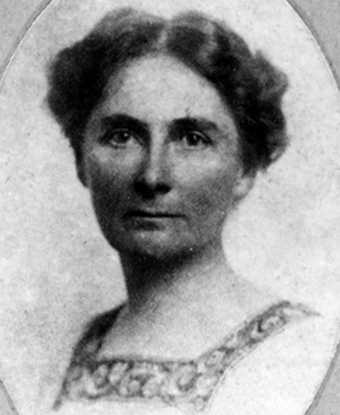Last updated: February 5, 2021
Person
The Stone Lady, Florence Bascom

USGS
Acadia had long been a destination for geologists, but Florence Bascom was the first professional female geologist to survey Mount Desert Island, publishing “The Geology of Mount Desert Island” in 1919.
The youngest of five children, Bascom was encouraged by her father (a philosphy professor) and her mother (an activist in the suffrage movement) to pursue science. She was born in Massachusetts and grew up in Wisconsin. After earning several degrees at the University of Wisconsin and selecting geology as her preferred course of study, Bascom applied to Johns Hopkins University.
The president of Johns Hopkins, Daniel C. Gilman, who was also a Northeast Harbor summer resident, opposed the co-education of women. But Bascom persisted, successfully petitioning for admission with support from her Wisconsin professors.
As was customary at the time, she was required to sit behind a screen in the corner of the classroom so as to not distract the male students. But she also finally had the chance to get outside and conduct fieldwork, studying the rocks of the Piedmont region of Maryland and Pennsylvania, work for which she became best known.
Newspapers around the region and nation carried word of Bascom’s graduation as the first woman to receive a doctorate from Johns Hopkins University in 1893. President Gilman sent her a letter from Mount Desert, “You have won your honors, as you must have wished to win them, without any favoritism, - just as all other candidates among us have won their diplomas, by talents, patience, and exertion...”
After briefly working at Ohio State, she took a position at Bryn Mawr College, then a women’s college, and began building a program in geology. Bascom emphasized field work for her students, a practice which often brought her into conflict with Bryn Mawr president M. Carey Thomas. In a letter to Bascom, who wanted her students to get physical education credit for geology field work, Thomas demands that the women wear appropriate apparel for the outdoors.
“We have talked over the possibility of asking the Self Government to alter the rule about not wearing atheletic skirts off the campus and we do not think this would be wise but every student ought to have a walking skirt and as soon as the members of your class are willing to provide themselves with such skirts the Health Committee will be willing to count the geological excursions of two hours as a substitute for the third hour of fixed exercise. “
Teaching was not enough. In order to be successful as a geologist, Bascom had to participate in the professional organizations and conduct mapping and survey work like a ‘regular fellow.’
In 1894, she became the second woman elected to the Geological Society of America, and in 1896 was the first woman to work for the U.S. Geological Survey. She conducted field work in the summer, while returning to Bryn Mawr the rest of the year for teaching, writing reports, and analyzing samples. She loved to work outdoors. “This is the life,” she wrote, “to plunge into the welcome isolation of the field…”
While the exact timeline of her visits to Maine remains to be reconstructed (did Gilman invite her to Northeast Harbor?) she likely began visiting Maine on behalf of the USGS shortly after her appointment as assistant geology. She visited the Damariscotta region around 1898, and corresponded with William Crosby, who previously studied the geology of Frenchman Bay.
Her report on Mount Desert was published in 1919, and reprinted by the Joint Path Committee of the Village Improvement Societies. It contains photographs by William C. Alden taken in 1907.
Bascom was a mentor to many, including Wildflowers of Mount Desert Island author Edgar Theodore Wherry, who was her assistant at USGS. She trained numerous female geologists to think critically and communicate their findings.
“When any woman manifests an interest in the science [of geology] I am always glad to tell her of its possibilities and she makes her own choice. Not only must a girl have the mental aptitude for scientific research, but also physical strength and great physical courage. Then too she must be strong in the conviction that it is the work she really wants to do,” wrote Bascom.
Florence Bascom did not cook, or iron. She was restless and independent. She loved horses and dogs. She retired in 1928 to the Berkshires in western Massachusetts.
She was also, apparently, a poet. This verse is contained in the collection of Florence Bascom Papers at Smith College.
The Hut
A hut and a tree
And a hill for me!
A dog, a horse, and upland meadows,
And I’ll ask no thing
Of man or king
Save to clear away their shadows.
References
Florence Bascom Papers, Sophia Smith Collection, Smith College, Northampton, MA.
Bascom, F. 1899. On some dikes in the vicinity of Johns Bay, Maine. American Geologist 23(5):273-280.
Bascom, F. 1919. The Geology of Mount Desert Island (revised and reprinted). Joint Path Committee of the Village Improvement Societies of Mount Desert Island.
Clary, R.M., and J.H. Wandersee. 2007. Great expectations: Florence Bascom (1842-1945) and the education of early US women geologists, pp. 123-135 in The Role of Women in the History of Geology (Burek, C.V., and B. Higgs, editors). London, UK: The Geological Society of London.
Smith, I.F. 1981. The Stone Lady: A Memoir of Florence Bascom. Bryn Mawr College.
